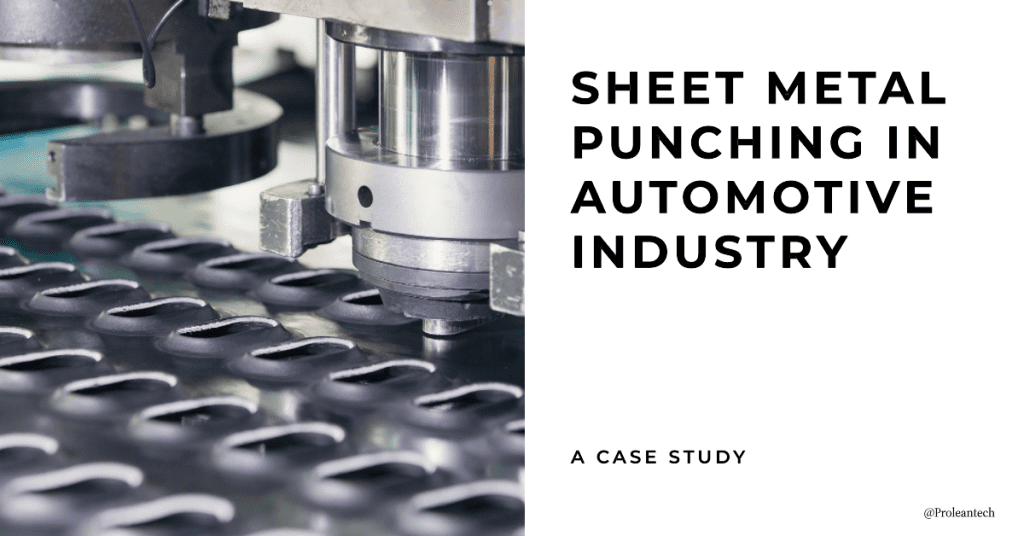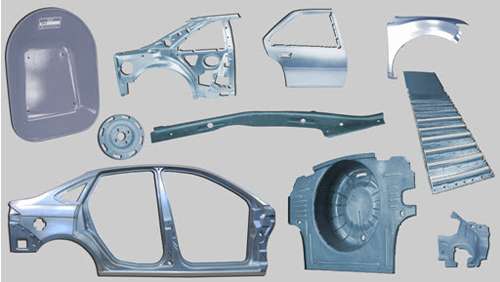
Sheet metal punching is a crucial process in the automotive industry, used for producing various components such as body panels, chassis, and structural parts. It involves the use of a punch and die to create holes or cutouts in sheet metal, allowing manufacturers to produce complex shapes and designs with precision and efficiency. As the industry evolves and embraces innovative technologies, sheet metal punching has become even more critical in driving advancements in automotive design and manufacturing.
In this article, We’ll explore the history, techniques, and benefits of sheet metal punching in the automotive industry. We’ll also examine a case study highlighting how this process drives innovation in design and consider its future impact on the industry.
The History of Sheet Metal Punching in Automotive Manufacturing
Sheet metal punching has been a part of automotive manufacturing since the early days of the industry. In the early 20th century, when mass production of automobiles began, manufacturers sought ways to produce components quickly and efficiently. Sheet metal punching emerged as a solution, enabling them to create intricate parts with minimal waste and reduced production times.
Over the years, sheet metal punching has evolved and improved, with the introduction of new materials, equipment, and techniques. The adoption of computer numerical control (CNC) technology in the 1980s revolutionized the punching process, allowing for greater precision, speed, and flexibility in the production of automotive components. Additionally, the development of high-strength steel and advanced materials has pushed the boundaries of what can be achieved with sheet metal punching, facilitating the creation of increasingly complex and lightweight designs.
Today, sheet metal punching remains a core process in automotive manufacturing, driven by the industry’s ongoing pursuit of innovation and efficiency. As we continue to explore its history and impact, it is essential to examine the various techniques and applications of this versatile manufacturing process.
Sheet Metal Punching Techniques and Applications

There are several sheet metal punching techniques used in the automotive industry, each with its unique advantages and applications. Some of the most commonly employed techniques include:
- Single-Punching: This technique involves using a single punch and dies to create a hole or cutout in the sheet metal. It is suitable for producing simple, low-cost components with relatively low production volumes.
- Turret Punching: Turret punching utilizes a machine with multiple punches and dies mounted on a rotating turret. This allows for rapid tool changes and the production of complex parts with multiple holes and cutouts. Turret punching is well-suited for the high-volume production of intricate automotive components.
- Progressive Punching: Progressive punching uses a series of punches and dies arranged in a linear or circular pattern on a stamping press. The sheet metal moves through the press, with each station performing a specific operation, such as punching, forming, or bending. This technique is ideal for producing complex, multi-step components with high precision and efficiency.
In addition to these techniques, sheet metal punching can be combined with other processes such as laser cutting, bending, and forming to create a wide range of automotive components. Examples of applications include body panels, structural parts, brackets, and chassis components, among others.
Advantages of Sheet Metal Punching in the Automotive Industry
The growing demand for lightweight yet robust vehicles has placed a significant emphasis on sheet metal punching as a viable option for automotive manufacturers. This process helps them achieve the desired weight reduction, fuel efficiency, and improved performance without compromising on safety and structural integrity.
There are numerous advantages of sheet metal punching in the automotive industry, including:
- Speed and Efficiency: Punching is a fast and efficient process, allowing manufacturers to produce large quantities of components in a short amount of time. This is crucial in an industry where high production volumes and tight deadlines are the norm.
- Precision and Accuracy: Modern punching machines, especially those equipped with CNC technology, can achieve high levels of precision and accuracy, ensuring that components meet the exact specifications required for their intended application.
- Design Flexibility: Sheet metal punching allows for the creation of complex shapes and designs, enabling automotive engineers to explore innovative design solutions without being limited by manufacturing constraints.
- Material Optimization: The punching process uses material efficiently, with minimal waste, which can result in cost savings and reduced environmental impact.
- Integration with Other Processes: Sheet metal punching can be integrated with other manufacturing processes, such as laser cutting, bending, and forming, to produce a wide range of components and meet the diverse needs of the automotive industry.
A Case Study: How Sheet Metal Punching Drives Innovation in Automotive Design
To illustrate the impact of sheet metal punching on automotive design innovation, let’s consider the case of a leading car manufacturer that sought to develop a lightweight, fuel-efficient vehicle without sacrificing safety and performance. By employing advanced sheet metal punching techniques and materials, the company was able to create innovative structural components and body panels that significantly reduced the vehicle’s weight while maintaining its strength and integrity.
The use of high-strength steels and advanced materials in combination with precise punching techniques allowed the manufacturer to engineer complex shapes and designs that maximized the material’s properties. This resulted in a vehicle with improved fuel efficiency, reduced emissions, and enhanced performance – a prime example of how sheet metal punching can drive innovation in the automotive industry.
The Future of Sheet Metal Punching
As the automotive industry continues to evolve and embrace new technologies, sheet metal punching is expected to play an increasingly important role in driving innovation and efficiency. Several key trends are likely to shape the future of this process and its impact on the industry:
- Advanced Materials: The development and adoption of new materials, such as ultra-high-strength steels, aluminum, and composite materials, will enable manufacturers to create increasingly lightweight and robust components using sheet metal punching techniques.
- Automation and Industry 4.0: The integration of advanced automation, robotics, and data analytics into the punching process will allow for greater precision, efficiency, and flexibility in component production, further enhancing the competitiveness of sheet metal punching in the automotive industry.
- Sustainability: As environmental concerns take center stage, sheet metal punching will play a vital role in the development of sustainable automotive manufacturing practices, through efficient material usage, reduced waste, and the production of lightweight, fuel-efficient vehicles.
Challenges and Solutions
Despite its many advantages, sheet metal punching also presents several challenges that need to be addressed to ensure its continued success in the automotive industry. Some of these challenges include tool wear and maintenance, material deformation, and the limitations of certain punching techniques in producing complex shapes and designs.
To overcome these challenges, manufacturers must invest in advanced equipment, materials, and training to ensure that their sheet metal punching processes are optimized for efficiency, precision, and performance. Additionally, they must be prepared to explore new techniques and technologies that can further enhance the capabilities of sheet metal punching and drive innovation in the industry.
Sheet Metal Punching Application Case Studies
Several companies in the automotive industry have successfully implemented sheet metal punching to create innovative components and designs. Some examples include:
- A Leading Electric Vehicle Manufacturer: This company employed advanced sheet metal punching techniques to develop lightweight and strong aluminum components for its electric vehicles, contributing to improved range and performance.
- A Global Automotive Supplier: By using progressive punching and high-strength steels, this supplier was able to produce complex, multi-functional brackets for various automotive applications, resulting in reduced part count, assembly time, and cost.
- An Automotive Component Manufacturer: This manufacturer utilized sheet metal punching in combination with laser cutting and bending to create intricate structural components that met the stringent safety requirements of the automotive industry while reducing weight and material usage.
These case studies demonstrate the versatility and potential of sheet metal punching in driving innovation and efficiency in the automotive industry.
The Role of Sheet Metal Punching in Sustainable Automotive Manufacturing
Sheet metal punching plays a crucial role in promoting sustainable manufacturing practices in the automotive industry. By using materials efficiently and minimizing waste, this process can help reduce the environmental impact of automotive production. Furthermore, the ability to create lightweight components using sheet metal punching techniques contributes to improved fuel efficiency and reduced emissions, aligning with the industry’s growing focus on sustainability and environmental responsibility.
As manufacturers continue to invest in advanced materials, equipment, and techniques, sheet metal punching’s role in sustainable automotive manufacturing is expected to grow even more significant in the coming years.
Conclusion
Sheet metal punching has played a pivotal role in the automotive industry’s history and continues to drive innovation and efficiency in component design and manufacturing. As we have discussed, this versatile process offers numerous advantages, including speed, precision, design flexibility, material optimization, and integration with other manufacturing processes.
At Prolean, we specialize in providing high-quality sheet metal punching services for a wide range of industries. Our team of experienced professionals is dedicated to delivering precision, efficiency, and customer satisfaction. Contact us Today!
FAQs
What is sheet metal punching?
Sheet metal punching is a manufacturing process that involves the use of a punch and die to create holes or cutouts in sheet metal. It is widely used in the automotive industry to produce various components, such as body panels, chassis, and structural parts.
Why is sheet metal punching important in the automotive industry?
Sheet metal punching is important in the automotive industry because it enables manufacturers to produce complex shapes and designs with precision and efficiency. This process helps achieve weight reduction, fuel efficiency, and improved performance without compromising on safety and structural integrity.
What are some advantages of sheet metal punching?
Some advantages of sheet metal punching include speed and efficiency, precision and accuracy, design flexibility, material optimization, and integration with other manufacturing processes.
What are some challenges in implementing sheet metal punching?
Some challenges in implementing sheet metal punching include tool wear and maintenance, material deformation, and limitations in producing complex shapes and designs.
How does sheet metal punching contribute to sustainable automotive manufacturing?
Sheet metal punching contributes to sustainable automotive manufacturing by using materials efficiently, minimizing waste, and enabling the production of lightweight components that can improve fuel efficiency and reduce emissions.




0 Comments